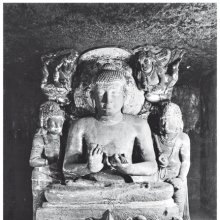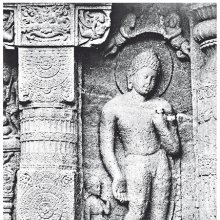Ajanta, Ajantā, Ajamta: 6 definitions
Introduction:
Ajanta means something in Hinduism, Sanskrit, the history of ancient India. If you want to know the exact meaning, history, etymology or English translation of this term then check out the descriptions on this page. Add your comment or reference to a book if you want to contribute to this summary article.
Images (photo gallery)
India history and geography
Source: Shodhganga: Ajanta’s antiquityAjantā (the caves) is an archaeologically important site in terms of ancient Buddhism.—The caves were primarily meant for the annual rainy season (varṣāvāsa in Sanskrit and vassāvāsa in Pāli). Archaeological Survey of India has numbered the caves from 1 to 29. All the caves belong to the Buddhist faith. The caves are generally described under two conventional nomenclatures: the ‘Hīnayāna’ phase and the ‘Mahāyāna’ phase. However, these nomenclatures have come under serious scrutiny in recent researches.
During the earlier phase, the region fell in the kingdom of the powerful Sātavāhana rulers. The latter group of caves were excavated when the region was being governed by the powerful Vākāṭaka dynasty with maximum territorial control during late fifth century. All the Vākāṭaka period cave sites are incomplete. They were abandoned during ca. 477–480 CE by the original patrons and the Saṅgha that was likely in charge of the affairs at the saṅghārāmas.
Source: Knowledge Traditions & Practices of India: Painting: A Survey (h)Ajanta is an archaeologically important site containing ancient Indian mural paintings.—The Ajanta caves consist of 30 rock-cut Buddhist caityas and vihāras which date from the 2nd century BCE to the 7th century CE and include paintings and sculptures described as “the finest surviving examples of Indian art, particularly painting”, with depictions of the Buddha and the Jataka tales. The Ajanta Caves are a Unesco World Heritage Site.
First (Sātavāhana) phase:—Caves 9, 10, 12, 13 and 15A make up the earliest group of caves built between 100 BCE and 100 CE probably under the patronage of the Sātavāhana (230 BCE–220 CE) who ruled the region. Caves 9 and 10 are caitya halls with stūpas, while caves 12, 13, and 15A are vihāras.
Second (Vākāṭaka) phase:—The second phase began in the 5th century and is often called the Mahāyāna phase. Caves of the second period are 1–8, 11, 14–29; some may be earlier caves extended or remodelled. Caves 19, 26, and 29 are caitya halls, while the rest are vihāras, many of them with a sanctum in the rear. In the caves of the second period the overwhelming majority of images represent the Buddha alone or scenes of his previous lives as well.

The history of India traces the identification of countries, villages, towns and other regions of India, as well as mythology, zoology, royal dynasties, rulers, tribes, local festivities and traditions and regional languages. Ancient India enjoyed religious freedom and encourages the path of Dharma, a concept common to Buddhism, Hinduism, and Jainism.
Languages of India and abroad
Sanskrit dictionary
Source: Cologne Digital Sanskrit Dictionaries: Shabda-Sagara Sanskrit-English DictionaryAjanta (अजन्त).—m. (-nta) (In grammar) A noun ending in a vowel. E. ac the syllable including all the vowels, and anta end.
Source: Cologne Digital Sanskrit Dictionaries: Aufrecht Catalogus CatalogorumAjanta (अजन्त) as mentioned in Aufrecht’s Catalogus Catalogorum:—[grammatical] Oppert. Ii, 6.
Source: Cologne Digital Sanskrit Dictionaries: Monier-Williams Sanskrit-English Dictionary1) Ajanta (अजन्त):—[=aj-anta] [from ac] a mfn. ending in a vowel.
2) [=aj-anta] b mfn. See 2. ac.
Sanskrit, also spelled संस्कृतम् (saṃskṛtam), is an ancient language of India commonly seen as the grandmother of the Indo-European language family (even English!). Closely allied with Prakrit and Pali, Sanskrit is more exhaustive in both grammar and terms and has the most extensive collection of literature in the world, greatly surpassing its sister-languages Greek and Latin.
Kannada-English dictionary
Source: Alar: Kannada-English corpusAjaṃta (ಅಜಂತ):—[adjective] ending in a vowel.
Kannada is a Dravidian language (as opposed to the Indo-European language family) mainly spoken in the southwestern region of India.
See also (Relevant definitions)
Ends with: Apaapajanta, Cajanta, Pabbajanta, Pariccajanta, Parissajanta, Sahajanta, Vibhajanta, Yajanta.
Full-text (+60): Bhutapurva, Ajantha, Bagh, Badami, Mandapa, Harishena, Buddhabhadra, Ac, Wall painting, Painting, Acinta, Svati, Simuka, Lashuna, Upendragupta, Lambodara, Xuanzang, Bhadrabandhu, Krishna, Meghasvati.
Relevant text
Search found 36 books and stories containing Ajanta, Aj-anta, Ajamta, Ajaṃta, Ajantā; (plurals include: Ajantas, antas, Ajamtas, Ajaṃtas, Ajantās). You can also click to the full overview containing English textual excerpts. Below are direct links for the most relevant articles:
Vastu-shastra (5): Temple Architecture (by D. N. Shukla)
Cave Temples of Ajanta < [Chapter 12 - History of Hindu Temples (Prāsādas and Vimānas)]
Layanas, Guhādharas and Guhārājas < [Chapter 12 - History of Hindu Temples (Prāsādas and Vimānas)]
Temples at Ellora and Elephanta < [Chapter 12 - History of Hindu Temples (Prāsādas and Vimānas)]
Amaravati Art in the Context of Andhra Archaeology (by Sreyashi Ray chowdhuri)
Amarāvatī impact on later schools of Indian art < [Chapter 5 - Impact of Amarāvatī Art]
Artistic Connectivity between Amarāvatī and Sri Lanka < [Chapter 5 - Impact of Amarāvatī Art]
Maha Prajnaparamita Sastra (by Gelongma Karma Migme Chödrön)
Part 9 - Ṣaḍdanta-jātaka < [Chapter XX - The Virtue of Generosity and Generosity of the Dharma]
The Śaśa-Jātaka < [I. Puṇyakriyāvastu consisting of generosity]
I. Acquiring precedence over the Śrāvakas and Pratyekabuddhas < [Part 3 - Acquiring precedence, etc.]
Pallava period (Social and Cultural History) (by S. Krishnamurthy)
Household Articles (d): Flower-basket (Pushpa-puta) < [Chapter 4 - Material Culture of the People]
Stringed instruments (Tata) < [Chapter 4 - Material Culture of the People]
Origin of Sculptural Art (c): Pallava period < [Chapter 2 - Origin of Sculptural Art—Its Development and Scheme]
Vastu-shastra (1): Canons of Architecture (by D. N. Shukla)
(v,2) Vāstu in Epic literature < [Chapter 4 - An outline History of Hindu Architecture]
(vi) Rise of Art < [Chapter 4 - An outline History of Hindu Architecture]
(ii) Subject-matter of Architecture (Vāstu) < [Chapter 2 - Scope and Subject-matter]
Related products






